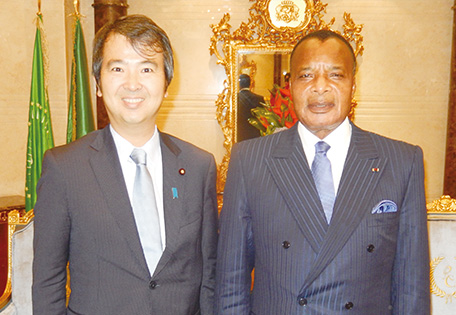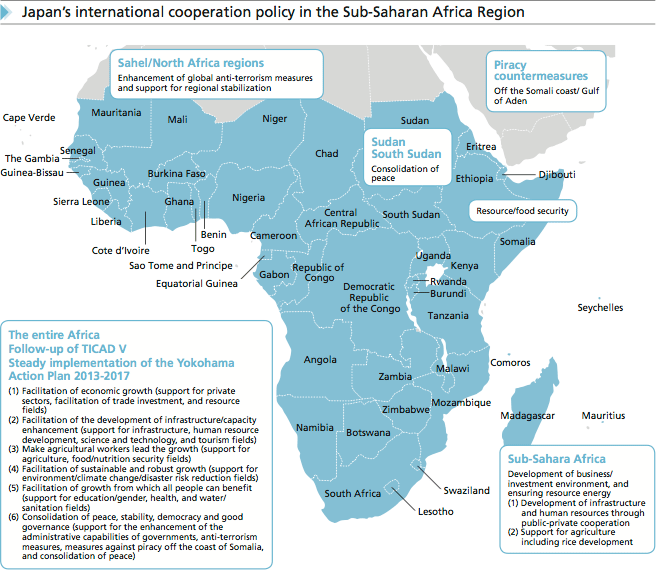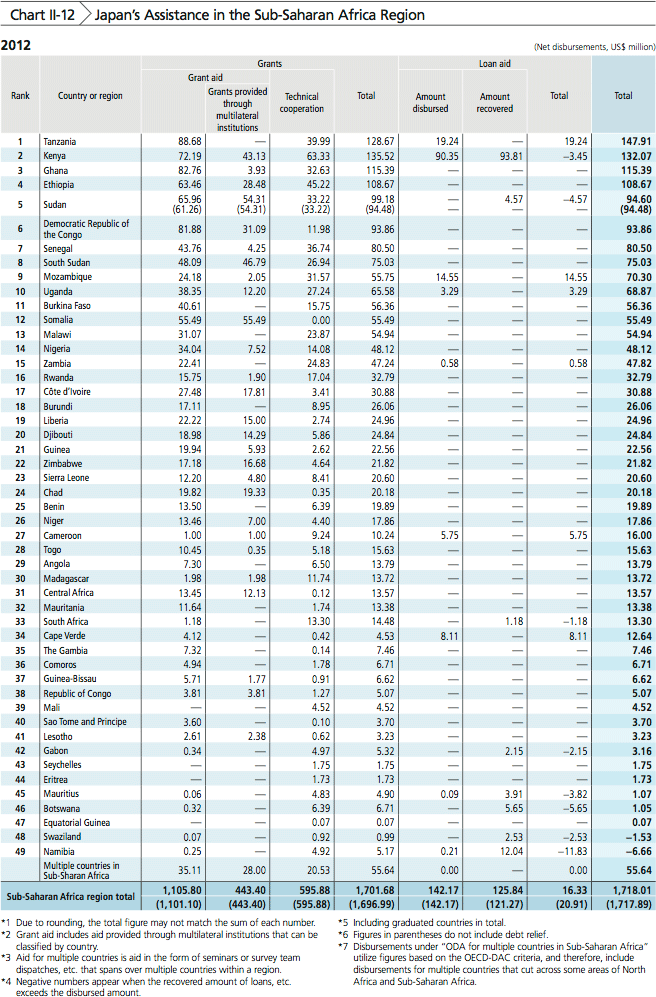Japan's Official Development Assistance White Paper 2013
5. Sub-Saharan Africa
Africa, in particular, “Sub-Sahara” continues to face serious problems of poverty. The majority of Sub- Saharan African countries (33 out of 48 countries) are Least Developed Countries (LDCs), where approximately half the population lives below the poverty line of $1.25 per day. In addition, many countries in the region face serious problems that hinder development, such as civil war and conflicts, refugees, famine resulting from drought, the spread of infectious diseases such as HIV/AIDS, and require a significant amount of aid from the international community. These problems in Africa are critical interests of the international community in such forums as the UN Security Council and the G8 Summit.
At the same time, with abundant natural resources and an increasing population, Africa has achieved remarkable economic growth in recent years. It is drawing expectations and attention from the international community and is expanding its presence as a “future global growth center.”
<Japan’s Efforts>
Japan has proactively supported the efforts by African countries in its efforts to address development challenges through the TICAD, which upholds the fundamental principle of Africa’s ownership as well as international cooperation (partnership).
In June 2013, 20 years after the launching of TICAD in 1993, the Fifth Tokyo International Conference on African Development (TICAD V) was held in Yokohama. TICAD V was joined by over 4,500 people from 51 African countries including 39 Heads of State, 31 development partner countries and Asian countries, 72 international organizations and representatives of regional organizations, and representatives of civil society such as the private sector and NGOs. The scale of the conference was larger than the last time, and it was one of the largest international conferences Japan has ever hosted.

Parliamentary Vice-Minister for Foreign Affairs Hirotaka Ishihara, who visited the Republic of Congo as a public-private joint mission for promoting trade and investment for Africa in November 2013, with President Denis Sassou Nguesso.
Under the overarching theme of “Hand in Hand with a More Dynamic Africa,” active discussions were held on the core themes of TICAD V; namely, “Robust and Sustainable Economy,” “Inclusive and Resilient Society,” and “Peace and Stability.” This led to the adoption of the Yokohama Declaration 2013 that sets forth the future direction of Africa and the Yokohama Action Plan 2013-2017 that identifies specific measures for the next five years which were adopted. Furthermore, reflecting the importance of private sector led growth, a “Dialogue with the Private Sector“ was held at a TICAD plenary session, which was the first session for direct engagement between African leaders and representatives of the Japanese private sector.
In this conference, Japan emphasized the development of infrastructure and human resources, and spelled out the assistance measures for Africa, such as up to approximately ¥3.2 trillion assistance by the public and private sectors, including approximately ¥1.4 trillion of ODA; development of business-savvy human capacities including the African Business Education Initiative for Youth (ABE Initiative); and development/humanitarian assistance in the Sahel region. Japan recognizes Africa as a business partner, and will support its growth through the promotion of trade and investment from the public and private sectors, within the assistance framework.
Japan also has been contributing to efforts to achieve peace and stability in the African region. Prior to TICAD V, Japan hosted the Special Conference on Somalia in May 2013. After a 21-year history of civil conflicts, Somalia overcame the hardship and established a new government and constitution in 2012, which now serve as the foundation of the nation. Now is an opportunity for the international community including Japan to hope for the peace and prosperity of Somalia. Stability in Somalia is important for the stability and prosperity of East Africa. It is also indispensable for fundamentally resolving the problem of piracy off the coast of Somalia and ensuring the safety of one of the major sea lanes of communication, one that plays a prominent role even on the global level, from the Indian Ocean into the Red Sea and then out through the Mediterranean Sea.
In March 2013, Japan decided to provide a new assistance package of $55.4 million and also to resume bilateral assistance to Somalia, aiming to contribute to Somalia’s nation-building efforts on a full scale basis. Japan will continue supporting Somalia’s nation building efforts through human-centered development.
In January 2013, a terrorist attack was launched against Japanese nationals in Algeria. Following this incident, Minister for Foreign Affairs Fumio Kishida announced three pillars of foreign policy on January 29, and expressed Japan’s determination to fight against terrorism together with the international community. The three pillars are: (1) strengthening of measures against international terrorism, (2) support for the stabilization of Sahel, North Africa, and Middle East Regions, and (3) promotion of dialogue and exchange with Islamic and Arab countries. As a concrete measure, in January 2013, Japan pledged to contribute $120 million to provide assistance for refugees in Mali and neighboring countries and to strengthen the capability to maintain public safety. Specifically, Japan provided food and tents for accommodating the refugees who escaped from Mali to neighboring countries, as well as provided support for the Peacekeeping Operation (PKO) Training Center in order to improve the military and police capacity in West African countries. Moreover, at TICAD V, Japan announced its contribution to improve the capabilities against terrorism in the Sahel region through 2,000 humanitarian resources and the provision of equipment and to the development and humanitarian assistance in the Sahel region through ¥100 billion assistance.

In August 2013, former Parliamentary Vice-Minister for Foreign Affairs Toshiko Abe visited a Malian refugee camp in Burkina Faso, and talked with the children at the camp.
●Mozambique
Rehabilitation, Improvement and Capacity Development for the Management of Nacala Port
Loan Aid Technical Cooperation - Associated Technical Cooperation Project, Grant Aid and Loan Aid (March 2012 - Ongoing)
Prior to formulating development strategies for the entire Nacala Corridor, Japan has been providing support for the development of the Port of Nacala, which will be an important hub for the development of the region. The Port of Nacala is located in a bay, making it less prone to the effects of ocean waves. It also has sufficient depth (maximum draught 14 m), allowing large vessels to dock. For these reasons, the port is one of the best natural ports of the southeast region of Africa, and plays an important role as a hub for domestic logistics and regional import and export.
However, the port facilities constructed during Portuguese colonial rule and the dock and surrounding facilities built more than 40 years ago have fallen into a state of disrepair. Additionally, due to a lack of equipment such as container cranes, the efficiency of loading and unloading is poor, and many have observed that this is an area that must be addressed during the port’s development plan.
In light of this, Japan has been facilitating urgent repairs through grant aid and has provided ODA loan to initiate civil engineering work to enhance port operations and allow the procurement of loading equipment. At the same time, Japan has also implemented a technical cooperation project to increase the efficiency of port maintenance, management and loading, and to improve maintenance and management capacity of port facilities and loading equipment. It is hoped that the completion of the project will triple the cargo handling capacity of the port.
Improvement works on ports and roads and the formulation of a regional development strategy all require significant time and effort. It cannot be expected that the effects of the project will be seen immediately. Nevertheless, with sights fixed on the development of Mozambique and southeast Africa in the coming 10 to 20 years, the team is working as one and taking steps forward.
(As of August 2013)
(See also “The Project for Nacala Corridor Economic Development Strategies in the Republic of Mozambique” on this page.)

Guidance being given on loading equipment maintenance (Photo: JICA)

A container ship berthed at a pier (Photo: JICA)
●Togo
The Project for the Study on Togo Logistics Corridor Development
Technical Cooperation Project (August 2012 - Ongoing)
Located in the Gulf of Guinea in western Africa, Togo is a long and narrow country, running from north to south. With the Port of Lomé, which serves as a hub for the region and the gateway to Togo, the country is striving to become a port nation. The logistics and transport infrastructure, including roads, bridges and railways that extend the 667 km distance between the Port of Lomé and the border of Burkina Faso, is known as the Togo Logistics Corridor. This infrastructure plays a crucial role in transporting goods discharged at the Port of Lomé to destinations within Togo, and surrounding inland nations (particularly Burkina Faso and Niger).
With the cooperation of Japan, the Togolese Government has formulated the national logistics transportation infrastructure development plan, which aims to ensure that the Togo Logistics Corridor functions reliably and smoothly. This plan focuses not only on National road No. 1 that runs down the narrow strip of land like a spine, but also peripheral branch roads.
Currently Togo relies heavily on National road No. 1, which has, despite being the biggest trunk road, very steep inclines and declines. Therefore, during the wet season and when accidents occur, traffic is severely disrupted. For these reasons, Japan has proposed the development of detour and alternative routes, and consequently, the Togolese Government formulated a plan prioritizing the development of these roads.
Furthermore, to promote the Togolese Government to take initiative in developing the Togo Logistics Corridor, Japan assisted three seminars that explained the importance of the development of the corridor to other development partners. Approximately 170 field workers and experts in infrastructure and regional development attended these seminars. It is expected that these Japanese initiatives will contribute to the further development of Togo, which is on its way to becoming a port nation.
(As of August 2013)

Port of Lomé that will become a gateway to Togo. A good natural harbor that boasts a water depth of 16m. (Photo: JICA)


